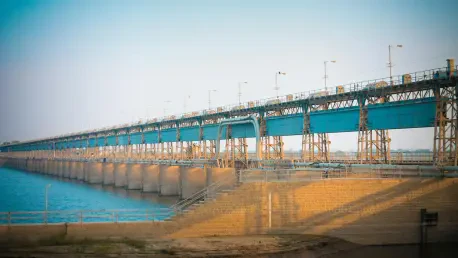Today, we’re joined by Christopher Hailstone, a seasoned expert in energy management, renewable energy, and electricity delivery, who provides valuable insights into grid reliability and security. Christopher, with his extensive expertise, will help us understand the implications and achievements of the monumental Site C project on the Peace River in British Columbia.
Can you tell us about the significance of the Site C project on the Peace River and why it is considered a ‘penultimate’ milestone?
The Site C project is considered a ‘penultimate’ milestone due to its scale and impact on the region’s energy supply. As one of the last major stages before full operational status, it represents significant progress towards increasing clean electricity supply, reinforcing its role as a pivotal component in ensuring energy security and sustainability for British Columbia.
How does the Site C project compare in size and cost to other infrastructure projects in British Columbia’s history?
Site C stands out as both the largest and most expensive infrastructure project in British Columbia’s history. With an estimated construction cost of $16 billion, it dwarfs other past infrastructure endeavors, illustrating the province’s commitment to advancing its energy infrastructure significantly.
What is the current status of the Site C project, and what milestones have been achieved so far?
The Site C project is nearing completion, with the fifth generating unit successfully commissioned. Testing and commissioning of the sixth and final generating unit are actively underway, indicating that we’re in the final stages of turning this ambitious project fully operational.
How many generating units are being built at Site C, and how many have been commissioned to date?
A total of six generating units are being constructed at Site C. To date, five of these units have been successfully commissioned, marking significant progress toward project completion.
What is the estimated electricity output of each generating unit at Site C?
Each generating unit at Site C is designed to produce over 180 megawatts of electricity, a substantial contribution to the region’s energy capacity and a testament to the project’s ambitious scope.
When is the sixth and final generating unit expected to be operational?
The sixth and final generating unit is expected to come online by this fall. The commissioning process is well advanced, maintaining the project’s trajectory towards full operational capacity soon.
Can you explain the impact of Site C on BC Hydro’s total electricity supply and what percentage increase it represents?
Upon completion, Site C will bolster BC Hydro’s total electricity supply by approximately 8%. This increase is significant, ensuring additional clean and reliable energy for British Columbia’s homes, businesses, and industries.
What is the expected annual electricity production of Site C in gigawatt-hours (GWh)?
The Site C project is anticipated to produce around 5,100 gigawatt-hours of electricity annually, reflecting its capability to meet substantial energy demands and support the province’s growth sustainably.
How does Site C integrate into the existing infrastructure on the Peace River?
Site C will be the third dam and hydroelectric generating station on the Peace River, enhancing the region’s existing energy infrastructure. By integrating into the established system, it builds on past investments and expands the overall capacity and resilience of the grid.
What are the environmental implications of the Site C reservoir, specifically concerning its size and surface area?
The Site C reservoir will be quite expansive, measuring 83 kilometers in length and covering about 5,550 hectares of land. Its total surface area will be approximately 9,330 hectares, presenting significant environmental considerations in terms of land use and ecosystem impacts.
What approvals and green lights were necessary for the Site C project, and when were these obtained?
The project required meticulous environmental reviews and received the necessary approvals from both federal and provincial governments in October 2014. The green light from the Government of B.C. came in December 2014, and construction commenced in summer 2015 after these key approvals were secured.
Can you provide an overview of the timeline for the construction of Site C, from inception to its current state?
The timeline for Site C began with environmental approvals in late 2014, followed by the start of construction the following summer. The project has progressed methodically, with the first generating unit coming online in October 2024 and subsequent units following, leading us to the current phase where the last unit is being commissioned.
How has Site C’s construction aligned with the goals of providing clean and affordable electricity for British Columbians?
Site C’s construction is a vital part of British Columbia’s strategy to deliver clean and affordable electricity. By harnessing renewable hydroelectric power, it supports the province’s efforts to lower carbon emissions and provide cost-effective energy to its residents.
What challenges, if any, have been faced during the Site C project’s development and construction phases?
As with any large-scale infrastructure project, Site C has faced several challenges, ranging from technical and logistical issues to environmental and community concerns. Addressing these hurdles has required thorough planning and adaptive project management to keep the project on track.
How has the involvement of workers contributed to the successful milestones achieved at the Site C project?
The dedicated efforts of our workers have been integral to achieving key milestones. Their expertise and commitment have driven the project’s progress, ensuring that each phase is completed with precision and quality.
Are there any future plans or additional phases projected for Site C beyond the commissioning of the sixth generating unit?
While bringing the sixth generating unit online marks the completion of initial construction efforts, ongoing assessments and potential upgrades may occur to optimize and enhance Site C’s performance and integration into the broader energy grid.
Do you have any advice for our readers?
Stay informed about the evolving energy landscape, as it directly impacts our communities and the environment. Engaging with and supporting sustainable energy initiatives can drive positive change and ensure a resilient and efficient energy future.









